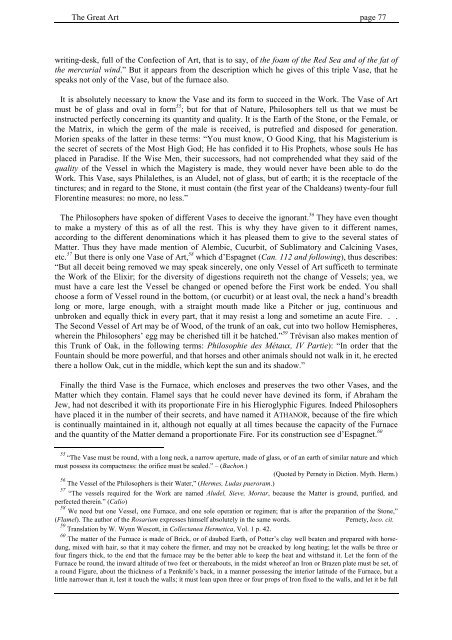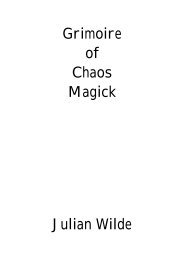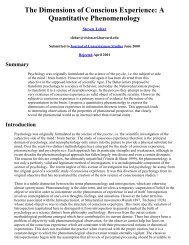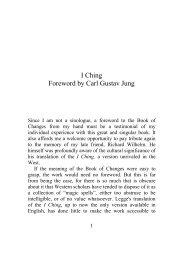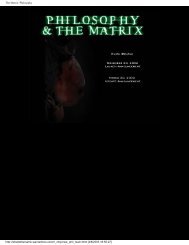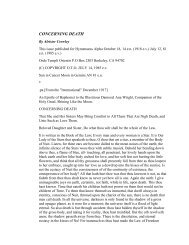Pernety - A Treatise On The Great Art.pdf - cyjack.com
Pernety - A Treatise On The Great Art.pdf - cyjack.com
Pernety - A Treatise On The Great Art.pdf - cyjack.com
You also want an ePaper? Increase the reach of your titles
YUMPU automatically turns print PDFs into web optimized ePapers that Google loves.
<strong>The</strong> <strong>Great</strong> <strong>Art</strong> page 77writing-desk, full of the Confection of <strong>Art</strong>, that is to say, of the foam of the Red Sea and of the fat ofthe mercurial wind.” But it appears from the description which he gives of this triple Vase, that hespeaks not only of the Vase, but of the furnace also.It is absolutely necessary to know the Vase and its form to succeed in the Work. <strong>The</strong> Vase of <strong>Art</strong>must be of glass and oval in form 55 ; but for that of Nature, Philosophers tell us that we must beinstructed perfectly concerning its quantity and quality. It is the Earth of the Stone, or the Female, orthe Matrix, in which the germ of the male is received, is putrefied and disposed for generation.Morien speaks of the latter in these terms: “You must know, O Good King, that his Magisterium isthe secret of secrets of the Most High God; He has confided it to His Prophets, whose souls He hasplaced in Paradise. If the Wise Men, their successors, had not <strong>com</strong>prehended what they said of thequality of the Vessel in which the Magistery is made, they would never have been able to do theWork. This Vase, says Philalethes, is an Aludel, not of glass, but of earth; it is the receptacle of thetinctures; and in regard to the Stone, it must contain (the first year of the Chaldeans) twenty-four fullFlorentine measures: no more, no less.”<strong>The</strong> Philosophers have spoken of different Vases to deceive the ignorant. 56 <strong>The</strong>y have even thoughtto make a mystery of this as of all the rest. This is why they have given to it different names,according to the different denominations which it has pleased them to give to the several states ofMatter. Thus they have made mention of Alembic, Cucurbit, of Sublimatory and Calcining Vases,etc. 57 But there is only one Vase of <strong>Art</strong>, 58 which d’Espagnet (Can. 112 and following), thus describes:“But all deceit being removed we may speak sincerely, one only Vessel of <strong>Art</strong> sufficeth to terminatethe Work of the Elixir; for the diversity of digestions requireth not the change of Vessels; yea, wemust have a care lest the Vessel be changed or opened before the First work be ended. You shallchoose a form of Vessel round in the bottom, (or cucurbit) or at least oval, the neck a hand’s breadthlong or more, large enough, with a straight mouth made like a Pitcher or jug, continuous andunbroken and equally thick in every part, that it may resist a long and sometime an acute Fire. . .<strong>The</strong> Second Vessel of <strong>Art</strong> may be of Wood, of the trunk of an oak, cut into two hollow Hemispheres,wherein the Philosophers’ egg may be cherished till it be hatched.” 59 Trévisan also makes mention ofthis Trunk of Oak, in the following terms: Philosophie des Métaux, IV Partie): “In order that theFountain should be more powerful, and that horses and other animals should not walk in it, he erectedthere a hollow Oak, cut in the middle, which kept the sun and its shadow.”Finally the third Vase is the Furnace, which encloses and preserves the two other Vases, and theMatter which they contain. Flamel says that he could never have devined its form, if Abraham theJew, had not described it with its proportionate Fire in his Hieroglyphic Figures. Indeed Philosophershave placed it in the number of their secrets, and have named it ATHANOR, because of the fire whichis continually maintained in it, although not equally at all times because the capacity of the Furnaceand the quantity of the Matter demand a proportionate Fire. For its construction see d’Espagnet. 6055 “<strong>The</strong> Vase must be round, with a long neck, a narrow aperture, made of glass, or of an earth of similar nature and whichmust possess its <strong>com</strong>pactness: the orifice must be sealed.” – (Bachon.)(Quoted by <strong>Pernety</strong> in Diction. Myth. Herm.)56 <strong>The</strong> Vessel of the Philosophers is their Water,” (Hermes, Ludas pueroram.)57 “<strong>The</strong> vessels required for the Work are named Aludel, Sieve, Mortar, because the Matter is ground, purified, andperfected therein.” (Calio)58 We need but one Vessel, one Furnace, and one sole operation or regimen; that is after the preparation of the Stone,”(Flamel). <strong>The</strong> author of the Rosarium expresses himself absolutely in the same words.<strong>Pernety</strong>, loco. cit.59 Translation by W. Wynn Wescott, in Collectanea Hermetica, Vol. 1 p. 42.60 <strong>The</strong> matter of the Furnace is made of Brick, or of daubed Earth, of Potter’s clay well beaten and prepared with horsedung,mixed with hair, so that it may cohere the firmer, and may not be creacked by long heating; let the walls be three orfour fingers thick, to the end that the furnace may be the better able to keep the heat and withstand it. Let the form of theFurnace be round, the inward altitude of two feet or thereabouts, in the midst whereof an Iron or Brazen plate must be set, ofa round Figure, about the thickness of a Penknife’s back, in a manner possessing the interior latitude of the Furnace, but alittle narrower than it, lest it touch the walls; it must lean upon three or four props of Iron fixed to the walls, and let it be full


